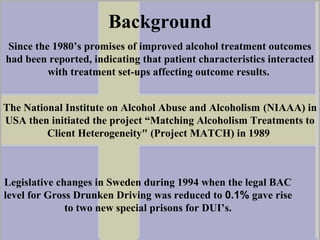Treatment of DUI’s
This document summarizes a study that categorized DUI offenders into subgroups based on personality traits and assigned them to different treatment programs. The study aimed to determine if certain client types benefited more from specific programs. 804 offenders were randomly assigned to one of three programs: Minnesota 12-step, Dynamic Cognitive Behavioral Modification, or Steering-Wheel Trap. Cluster analysis identified two main client types. The results showed that while no single program was superior, criminal, neurotic and antisocial clients generally benefited more from the treatments than less problematic clients. A trend also indicated that antisocial and neurotic clients benefited particularly from the Dynamic Cognitive Behavioral Modification program.

Recommended
Recommended
More Related Content
Similar to Treatment of DUI’s
Similar to Treatment of DUI’s (20)
More from Anders Andrén
More from Anders Andrén (6)
Treatment of DUI’s
- 1. Background Legislative changes in Sweden during 1994 when the legal BAC level for Gross Drunken Driving was reduced to 0.1% gave rise to two new special prisons for DUI’s. Since the 1980’s promises of improved alcohol treatment outcomes had been reported, indicating that patient characteristics interacted with treatment set-ups affecting outcome results. The National Institute on Alcohol Abuse and Alcoholism (NIAAA) in USA then initiated the project “Matching Alcoholism Treatments to Client Heterogeneity" (Project MATCH) in 1989
- 2. Special prisons for DUI’s Rostorp in MalmöRostorp in Malmö Östragård in VänersborgÖstragård in Vänersborg
- 3. The programs The treatment programs chosen for implementation were “The Minnesota 12-step model” (12-step) based on the principles of the Minnesota model (Reality Therapy) and Rational-Emotive Therapy (RET). “Dynamic Cognitive Behaviour Modification” (DCB) based on social learning theory. “The Steering-Wheel Trap” (SWT) or just “The Trap”, based on education and motivational psychology.
- 4. Objectives (1) Is it possible to categorize clients in meaningful subgroups with respect to psycho-social and personality characteristics? (2) Will certain client types benefit from certain programs in terms of an improved psycho-social situation, including less alcohol use at follow-up? (3) Is any program superior to the others, disregarding type of client? (4) If so, does the program effect varies with type of institution?
- 5. During the years 1996 to 1998 5 330 persons of both sexes were convicted to prison in Sweden because of one or several DUI crimes. 980 (1.2%) male clients were brought to the DUI-specialized prisons of Rostorp and Östragård. 804 clients (82%) accepted participation in the study and were randomly allocated to one of the programs. 216 (26.9%) at Rostorp and 588 (73.1%) at Östragård. . Subjects
- 6. Materials All clients were investigated with respect to their social situation, health, work and income, criminality, alcohol– and drug use and personality at intake. Mean treatment time was 6 weeks Voluntary participation in research program Random allocation of participants to treatment programs Clients were followed up 2 years after treatment
- 7. Instruments Addiction Severity Index Physical health Work and income Alcohol use Drug use Criminality Relations to family and friends Psychic health NEO-PI-R Neuroticism Extraversion Openness Agreeableness Conscientiousness
- 8. Statistical analysis PSD-delta scores (Psycho-Social Development) The difference between the ASI pre and post index scores PDM-delta scores (“Problem Days last Month) Pre- and post difference for number of days with problems last month. •Cluster Analysis: Client typology. •Main effects for programs, institutions and client typology: One-way ANOVA´s •Interactions between program and client typology and between program and institution: Two-way ANOVA´s Statistical methods
- 9. Results: Cluster Analysis (I) 46.90 63.90 53.94 45.14 50.36 47.17 50.73 45.27 51.17 36.87 48.18 53.65 47.88 54.86 46.20 57.61 47.73 55.86 48.16 54.14 48.21 53.86 45.76 57.41 Neuroticism Extraversion Openness Agreableness Conscientiousness Physical problems Work related problems Alcohol related problems Drug related problems Problems related to criminality Problems with relations to family and friends Psychic problem 1 2 Cluster
- 10. Results: Main effects for psycho- social developement (PSD) Main effects Physical health Work & income Alcohol use Drug use Crimina-lity Relations Psychic health Institution n.s n.s n.s n.s n.s n.s n.s Program n.s n.s n.s n.s n.s n.s n.s Client type F = 6.97, Df: 1, p<-05 F = 10.86, Df: 1, p<-05 F = 26.0, Df: 1, p<-05 n.s F = 7.65, Df: 1, p<-05 n.s F = 7.65, Df: 1, p<-05
- 11. Results: Interaction between program and client typology Delta scores Physical health Work & income Alcohol use Drug use Criminality Relations Psycic health PSD n.s n.s n.s n.s n.s n.s n.s PDM n.s n.s F = 5.85, Df: 2, P<-05 F = 3.54, Df: 2, p<-05 n.s n.s n.s
- 12. In conclusion The results in this study support the conclusions of Project Match.All the treatments were effective but none was shown to be superior to any other. There was a client effect indicating that criminal, neurotic and antisocial DUI´s generally have more to gain from the treatments than more “normal” DUI´s with less psycho-social problems. There were few interactions between treatments and clients and the “matching hypo- thesis” got meagre support, but a trend was observed the “antisocial and neurotic” DUI’s benefit particularly from the DCB program.
